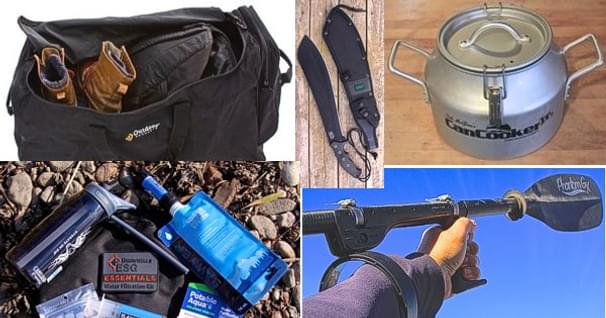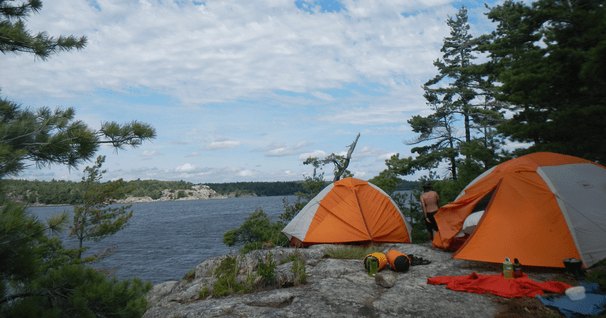’Thickening Up’ for Cooler Paddling
Mark Twain once described the Mississippi River as being "too thick to swim it and too thin to plow!" I'd like to offer a similar comparison on a different subject: the transition from warm summer kayaking conditions when it's too cold for cotton shorts but too warm for the wooly farmer johns. I'm referring to those brisk fall days when the water is still warding off that first glazing crust of ice and the wind still has a few leaves to pick from the trees. It's not time to put the kayak away, either.
I call it "Thickening" time - time to go from t-shirts to fleece, from soups to stews and from paddling shorts to long johns. It's a time when that summer weight bag just isn't thick enough to hold the heat. Here are a few thickening tips you can put into action to stretch your comfort level as far as you might stretch your open water paddling opportunities - especially in the North Country.
Thicker Fashion There is a saying in sea kayaking that you should "dress for the water temperature, not the air temperature." That's certainly true in principle when you think about summer water temperatures in many paddling regions being in the fifty-sixty degree range. In Kodiak where I spent a good deal of time on the water, the temperature in August was barely at fifty degrees!
Dressing for emersion meant layers of wool or neoprene that would bake the sweat right out of you on a warm north Pacific afternoon. Even at the lower latitudes, such imbalances occur as well. However, when fall season rolls around and the daylight shrinks and northern winds begin to blow, an added layer is smart and safe. Sometimes a windbreaker is all that is needed. Whatever arrangement of layers you prefer, consider either thicker fleece or doubling what you normally wear.
This goes for torso and legging protection. It also goes for hands. Perhaps your "thickenings" procedure is to either add gloves or pogies to your paddling wardrobe. I hate wearing hats or caps, but realize the warmth retention factor each provides. I actually let my hair grow longer in the winter time for the same purpose. Adding a hat or cap to your otherwise uncovered head will give you increased warmth whenever you wear one.
Sleeping Warmer
A rule for choosing a sleeping bag has always been to buy a bag rated for ten degrees colder than you ever expect to use it. That way you've invested in an extra envelop of warmth at the onset. In warmer climates some kayakers probably get by with summer weight bags all year long. An easy way to "thicken" up those bags is to simply add a bag liner made of flannel, fleece or silk - as these will each add ten to perhaps twenty degrees to the lower range. Of course you can always own several sleeping bags.
You can also thicken your sleeping pad or floor liner. I go for the comfort factor and prefer most any of the higher tech self-inflating pads or closed cell pad to provide both softness and insulation. Lastly, it's not a bad idea to add a liner to your tent floor if you don't already to slow down wear and tear. For years I've used a "space" blanket for that purpose.
OK, that's the basics of thickening as far as transitioning gear goes. Here are some other ways to start warding off the cooling environment.
Thick Soups
Turn those thinner, water-based soups into thicker stews for added rib-sticking fulfillment. There are several ways to accomplish this: you can add an ingredient that will absorb any excess water such as noodles or rice. Practice will teach you how much to add for the desired body. The easy out for this is that you can always add more water or other liquid to bring it back to center.
Another way is to add "professional" thickeners such as corn starch or flour. Corn starch absorbs twice as much as the same amount of flour so you can adjust any recipe calling for flour as the thickening agent by just adding half that amount of corn starch. Usually a table spoon or two goes a long way to thicken even a large pot. Be careful if you enjoy delicate tastes since both of these tend to make stuff taste bland - and doughy (flour).
Lastly, you can simply boil down the soup until it thickens up. This requires attention. Otherwise you might be kept warm by scraping all the burnt crud out of the bottom of the pot.
Tents & More
Sometimes you can change your habits a bit to extend the seasons or provide extra warmth you didn't need earlier on. Pitching your tent further back in the trees or brush line can add a few degrees by being out of the wind. You can also orient your tent to catch warming morning rays.
Extending the season by keeping warm without adding too many restricting layers means a few more outings in those crisp fall days or pushing the number of runs on a small stream before freeze-up. I'm sure you'll find other ways to "thicken up" if it means another chance to get out on the water.
Tom Watson, an avid sea kayaker and freelance writer is also the author of "How to Think Like A Survivor" available on Amazon.com and most major bookstores.
Related Articles
Like kids in a candy shop, we geek out every year at Canoecopia in Madison, WI. One of the few chances…
Each year the outdoor industry pulls back the curtain to showcase more and more "stuff" for us to drool…
"The tents weren't all that great, and I often slept under a canoe and would wrap my head in a towel to…
Kayak camping is not all that different than backpacking - if anything it is easier as you don't have to…


